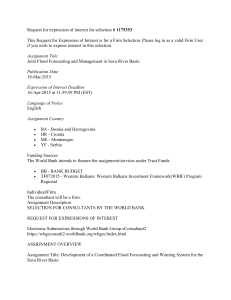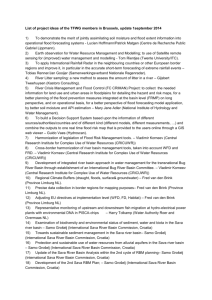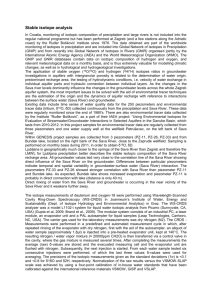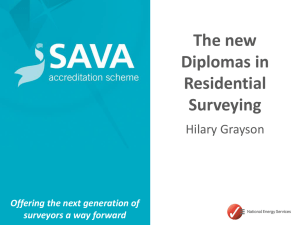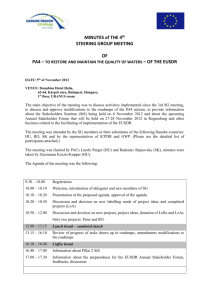NON PAPER
advertisement
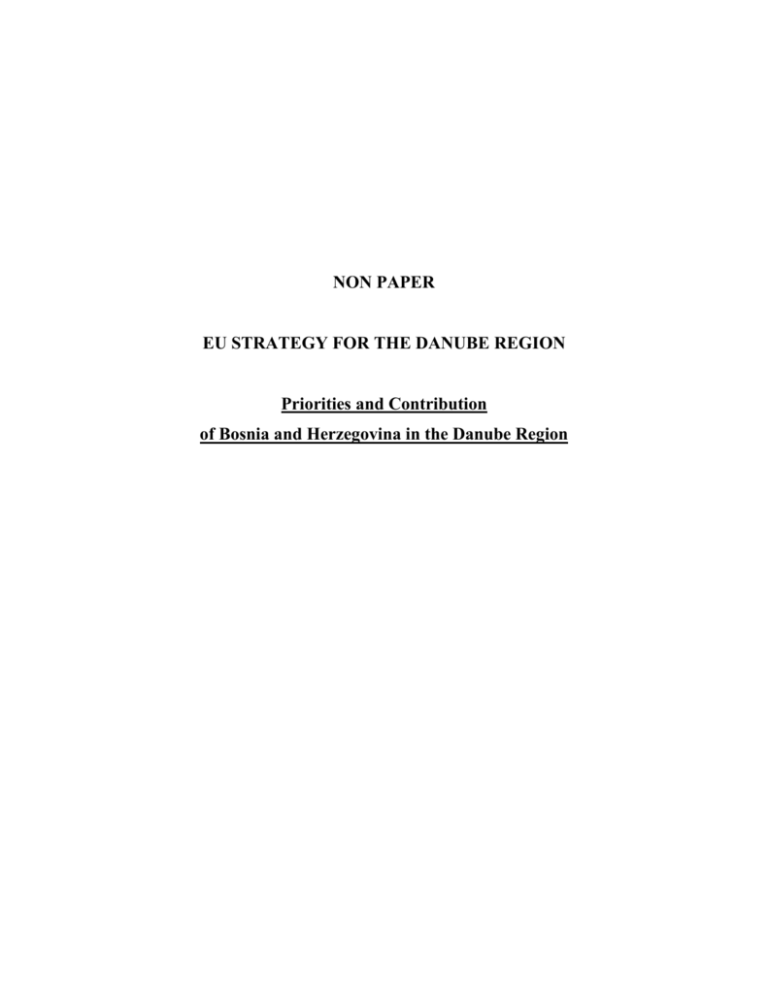
NON PAPER EU STRATEGY FOR THE DANUBE REGION Priorities and Contribution of Bosnia and Herzegovina in the Danube Region European Union Strategy for the Danube Region – EUSDR Relying on its successful and proven approach to macro-regional strategies in the European Union, during the meeting in June 2009, European Council mobilized European Commission to develop the EU Strategy for the Danube Region by the end of 2010, with the expected beginning of its implementation in the first half of 2011. The fact that the EU Strategy for the Danube Region is not only exclusive to EU membership, but encompassing all Countries represented in Danube Co-operation Process, gives an enormous opportunity to the Region as a whole. This new partnership will be particularly efficient in the Western Balkan, where the political, economic, cultural, ecological and other potentials of Danube area are far from being fully met. Considering geography, heritage, economy and culture, the Danube basin represents both the historical link and the main doorway for European future of Western Balkan States. Therefore, EU Strategy for the Danube Region is an invaluable instrument for Bosnia and Herzegovina in fulfilling its main geopolitical priority. Bosnia and Herzegovina and the Danube Region Bosnia and Herzegovina, which is an integral part of the Danube basin through the river Sava (the 945 km long main tributary of Danube River), fully supports the EU Strategy for the Danube Region and is a firm believer that this coordinated effort between the countries and other stakeholders of the Region can contribute to sustainable development, not only for this part of Europe, but for the Continent as a whole. Improving connectivity and communication systems, preserving environment and prevention against natural risks, and reinforcing the potential for socio-economical development, the so-called “three pillars” of the early stage of Implementation of the EU Strategy for the Danube Region, fully coincide with the strategic priorities of Bosnia and Herzegovina. Bosnia and Herzegovina is a natural geographical and historical link between Danube Region via Pannonian plain and the Mediterranean Region via Adriatic Sea. This is both an opportunity and the challenge for Bosnia and Herzegovina, which if properly exploited can contribute the further development of the Danube macro-region, reinforcing the communication and trade in particular. Priorities and Contributions of Bosnia and Herzegovina The Priorities and Contributions of Bosnia and Herzegovina to the EU Strategy for Danube Region are those projects, which are of high importance for sustainable development of the Sava River Basin. Those are generally oriented toward the environment protection, natural risk prevention, socio-economical development, and improvement of the connectivity and communication systems in the region. The following Projects are considered of High Importance by the International Sava River Basin Commission; - Development of the Sava River Basin Management Plan With the Signing of the Framework Agreement on the Sava River Basin, the representatives of Bosnia and Herzegovina, Croatia, Serbia and Slovenia have proved their commitment to develop a Common Sava River Basin Management Plan (Sava RBM Plan). The development of this Plan is one of the main tasks of the International Sava River Basin Commission. Activities on the Implementation of the Plan have began in 2006. The first phase in the Plan development - the preparation of the Sava River Basin Analysis has been successfully finalized. The Analysis and the commitment of the parties involved has received a positive reception by the European Commission, which resulted in the decision by the EC to support the remaining steps in developing the first Sava RBM Plan by the end of 2011. Planned period for the implementation of the Project is December 2009 – December 2011. The main goal of the Project is the preservation of the environment and prevention against natural risks. - Establishment of the Sava GIS As a part of the obligation resulting from the Framework Agreement on the Sava River Basin (FASRB), an analysis on GIS capabilities and current and future needs of the Parties has been performed in 2007. As the Next step, the Sava GIS Strategy has been prepared and adopted by the International Sava River Basin Commission (SRBC) in 2008. The main object of the Strategy is to establish an effective and efficient (geo)information system and spatial data infrastructure to support a wide range of water management planning activities of the ISRBC. The Sava GIS aims to provide good communication channels to the Parties of the FASRB primarily, for sharing and disseminating knowledge about water resources, an effective and efficient river basin management and planning in the Sava River Basin. A second major goal is to create a technical context and establishment of environment in which Parties will be able to work in accordance with the open and interoperable principles and criteria. The Establishment of the Sava GeoPortal is a basis for permanent and effective data and information exchange between the Parties to the FASRB in the Future. The Sava GeoPortal will be maintained under the supervision of the ISRBC. The implementation period for the Project is from December 2009 – December 2013. - Hydrological Study for the Sava River Basin The ISRBC initiated the activities in preparation of the Hydrological Study for the Sava River Basin by developing the Hydrology Report. It has been prepared for the purpose of the Sava River Basin Analysis. It provides very good overview of the current state of the meteorological and hydrological issues at the Sava River Basin level. The Hydrological Study will, due to its fundamental character, provide an essential input for all parties of importance for the FASRB implementation. Therefore, development of this Study was supported by high representatives of the countries, at the 2nd Meeting of the Parties to the FASRB (1, June 2009), by mentioning the Study explicitly in the Declaration from the Meeting. The Hydrological Study will address all meteorological and hydrological elements relevant for integrated water management in the Sava River Basin, based on mutually agreed methodology and period of analysis. It will provide a reliable and measurable basis for all decision and recommendations related to sustainable water resources management. The result of the common hydrology study will be directly used by other projects dealing with water management (e.g. Sava RBM Plan, PoM, Flood Risk Management Plan, Contingency Plan, etc.) The implementation period is 30 months. - Flood Mapping Study for the Sava River The International Sava River Basin Commission (ISRBC), with its Permanent Expert Group for Flood Protection (PEG FP) as the leading body, coordinates activities in the field of flood management. Within this framework, the PEG FP identified a need to develop a single hydraulic model of the Sava River and, in time, the major tributaries having the basin area greater than 1000 km2. The hydraulic model, to be prepared through cooperation with the US Army Corps of Engineer (USACE), will be used for flood mapping, supporting the flood forecast system, and for the purpose of development of future flood protection projects. - Building the link between Flood Risk Management planning and climate change assessment in the Sava River Basin Under the UNECE Water Convention, the Sava River Basin was chosen as one of the three pilot projects on climate change adaptation, upon proposal of the ISRBC, the other two being Chu Talas and Dniester. Considering the significant activities directly related to climate change are ongoing in the Sava River Basin (i.e. the project Water Climate Adaptation Plan for the Sava River Basin - WATCAP), this Project aims to build the link between flood risk management planning and climate change assessment in the Sava River Basin. The result of the project will be incorporated into the Flood Protection Management Plan. Developmnet of the Flood Protection Management Plan is one of the main objectives of the FASRB and Protocol on Flood Protection to the FASRB, which was signed by the parties on June 1, 2010. The main concern of this Project is the preservation of the environment and prevention against natural risk. The implementation period is set between June 2010 and the autumn 2012. - Water and Climate Adaptation Plan for the Sava River Basin According to the last findings on climate change, the Sava River Basin is predicted to experience higher temperatures and more seere precipitation events and droughts. These changes will impact water resources management, water supply, hydropower, agriculture, navigation and flood control. To fill the knowledge gap on the impact of climate change on water sector and to inform decision making sector how to increase the climate resilience of the critical water management, the World Bank has initiated the Project Water and Climate Adaptation Plan for the Sava River Basin. The Project is developing in parallel with the Sava RBM Plan. The result will be directly incorporated in to the Sava RBM Plan and other projects and programs (e.g. PoM). The implementation period is set between June, 2009 – mid 2011. - Development of the Hydrometeorological Information and Flood Forecasting and Warning System for the Sava River Basin The project preparation has been initiated by the national hydro-meteorological services from the Sava River Basin countries, based on understanding that an adequate hydrological information, as well as the flood prediction and warning system, are a prerequisite for an integrated water resources management and flood risk management in the basin. The Project will focus on establishment of the common hydro-meteorological information and flood forecasting/warning system and capacity building of national authorities dealing with water management issues through improvement of information management, hydrological forecasting and flood warning capabilities. The System will also be incorporated in the existing system of civil defense. The implementation period is between June, 2011 and May, 2013. - Water Pollution Contingency Management Plan for the Sava River Basin The Project is dealing with the water pollution contingency management to connect the institutions involved in water management and those involved in the emergency preparedness and response management. The project is aimed at efficient provision of measures in the case of accidental spills of substances which might affect the use of water for different purposes (drinking water, irrigation, industry, navigation etc.), as well as the quality of rivers and aquatic eco-system. For the purpose of efficient and effective management, the modeling and information exchange platform will be developed by which all responsible authorities and institutions will be alerted by eventual spill of harmful substances, follow the development of the situation and coordinate a concerted response to it. The project aims at the establishment of the efficient system for early warning system in case of emergency situation affecting the water regime and aquatic eco-system. The implementation period will depend upon the availability of funds. - Biodiversity and Environment Status of Sediment, Water and Biota in the Sava River Basin The Project will be focused mainly onto the integration of EU directives, such as the EU WFD, Habitat Directive, Bathing Directive, with the FASRB. A comparable dataset on environment status on the Sava River and its selected tributaries will be developed and sampling procedure and methodological approaches for hydro-morphological, physical-chemical, chemical, eco-toxicological and biological analysis of water, sediment and biota will be harmonized on transboundary scale. The system for efficient data exchange will be established and know-how transfer between project partners and other relevant institutions in the Sava River Basin will be provided. The ecological status of the Sava River Basin will be evaluated on the base of the data collected. Outcomes of the project will serve as the basis for application of the EU directives and sustainable water management activities which are crucial for development and implementation of the Sava River Management Plan, as well as the management of natural assets and protected areas. The results of the project will be incorporated into the PoM and into the next circle of development of the SRBMP. Period for implementation of the project is set within the frame of the next cycle of development of the Sava River Basin Management Plan (2011 – 2014). - Development of the Nautical Tourism in the Sava River Basin The Main purposes of this Project are to investigate development possibilities for the nautical tourism in the Sava River Basin, to recommend the strategy and programs and to provide an appropriate economic and organizational framework for the development of the nautical tourism in the Sava River Basin. The object is to reinforce the potential for socio-economical development. The implementation period for the Project is 12 months. - Rehabilitation and Development of Transport and Navigation on the Sava River Waterway The Sava River is navigable through 594 km of its river course and links the economies of four countries. The existence of port infrastructure on the Sava itself and the connection of the Sava with the Danube, provides great advantages for intensifying further development of the river transport. Despite of such natural advantages the Sava River Waterway has been neglected for the last fifteen years, and its current state-of-condition is bad due to many external and internal factors. During this period the economical development has mainly slowed down and the maintenance of the Sava River Waterway was on a low level. In addition, due to the decrease of the industrial production and the economic problems the transport on the Sava River, similar to the other types of transport, is on a low level and suffers serious lack of financial sources and maintenance. Although transport volumes in the past were higher than at present, the full potentials of the waterway transport were not adequately used in the past. This can be illustrated by the fact that waterway transport in EU countries has risen for 12% during the period of 1970-1998, while waterway transport in the countries of Central and Eastern Europe has declined for 20% during the period of 1990-1998. The main objective of the Project is rehabilitation and development of the Save River waterway infrastructure and provision of an appropriate economic and organizational framework for restoring trade and navigation on the Sava. The implementation period is five to six years. - Establishment of the Sava River Information Service (RIS) The Sava is presently largely underused, river transport being limited to scarce traffic on small river sections. The ISRBC has undertaken a number of activities to improve navigation on the Sava river, including the preparation of Prefeasibility Study and Feasibility Study for development and rehabilitation of navigation on the Sava river, Detailed design and prototype installation fro RIS on the Sava river, adoption of several very important regulations related to technical issues and safety of navigation, preparation of Detailed design for the marking of the Sava river on the B&H marking section, and restoration of waterway marking system. Logical step forward is implementation of a new technology – River Information Services – which will dramatically improve safety on inland waterway navigation on the Sava River. The aim of the Project is harmonized implementation of the RIS on the Sava River inline with already undertaken measures by Serbia and Croatia on the Danube, as well as with requirements of the EU RIS Directive. Development of RIS on the Sava River shall improve safety, efficiency, and environmental concerns. The approximate implementation period is three years. - Establishment of the system for collection, treatment, and disposal of hazardous and other ship waste on the Sava River The currently not used capacity potential that the Sava offers for future transport solutions is a great challenge for inland navigation, in particular as it is considered at present the most environmentally friendly transport mode. On the Sava River, compared to 2008, the transport volume for inland navigation is expected to significantly increase until 2015. As a result of these challenges inland navigation will face the need for the prevention of environmental risks related to the increase of ship waste. As ship waste management in practice shows partly significant differences in the Sava riparian countries, a substantial solution requires to solve existing lacks of adequate ship waste management in transnational cooperation along the Sava River. The implementation period for the project is five years. THE PROJECT CORRIDOR VC European traffic route on the Pan-European corridor V, from Baltic to Adriatic Sea, stretches from the north of Europe, through Hungary, on south towards Adriatic Sea and it finishes in Croatian port Ploče. Its branch Vc stretches from Budapest via eastern Croatia and Bosnia and Herzegovina and finishes in Port Ploče, Croatia. Route of this motorway is a part of European road network marked E73 and it represents the basis of road traffic infrastructure in Bosnia and Herzegovina. Existing quality of this motorway corridor branch does not meet the modern standards and needs. Completion of the Corridor Vc will dramatically improve the link between the Central Europe and the Adriatic Sea, which is of the crucial importance for the economical, cultural, and social development of the Region and of great importance for Europe as a whole. Currently, the part of the motorway connecting Bosnia and Herzegovina’s capital Sarajevo and Zenica, an industrial city in central Bosnia and Herzegovina, is under construction. The implementation period for the completion of the Project depends largely on the available funds. OTHER PRIORITIES AND AREAS OF BOSNA AND HERZEGOVINA’S COOPERATION Energy development in the Region requires a strong strategic planning on national and regional level. Increasing the potential of the energy supplies multiplied by the use of renewable sources of energy like the sun, wind, biomass etc. guarantees a sustainable regional development and environmental protection. The Sava River Basin and the Danube Region offers tremendous potential for the development of all kinds of tourism (sport fishing, eco-tourism, excursions, and hunting, to name athe few). The infrastructure, logistical support and protection of areas of natural and cultural heritage must be significantly improved and developed in order to satisfy the potentials this area has to offer. Joint regional cooperation is necessary to create an environment in which these goals can be met as soon as possible. The small and medium enterprises are the backbone of any healthy national and regional economy. The Sava River Basin has a great potential for the development and intensification of these particular business communities. In order to improve this sector of industry further environment friendly infrastructural and support development is necessary, as well as proper utilization and protection of agricultural potential, and modernization and preservation of freshwater fisheries. Culture, Sport, and education are an area where the regional cooperation is sine qua non for any further development. Joint cultural, sporting and educational gatherings and project, with the special emphasis on youth, can be a great contributor in improvement of inter-ethnic relations, peace, tolerance, and social prosperity in general. Ever since the end of the war in former Yugoslavia, clearing the mine-suspected areas is one of the most difficult and important challenges the Region is faced with. The agriculture in the Sava River Basin area, canal and embankment network on the Sava River, areas adjacent to transport infrastructure, borderline areas, etc. are all affected by landmines and the negative economical, social, environmental and cultural impact is clearly evident. Regional de-mining is a long and arduous task, which requires carefully designed strategy on the Regional and macro-regional level. EU Strategy for the Danube Region is an invaluable instrument for Bosnia and Herzegovina in fulfilling its main geopolitical priority Euro-Atlantic integration process and strengthening regional cooperation. Bosnia and Herzegovina places high hopes in political aspect of the Strategy where further assistance is required to coordinate the efforts in the process of EU accessions for candidate and potential candidate countries. Conclusion The close cooperation between EU and non-EU Member States gives Danube Strategy a specific role in the process of strengthening, two decades ago, virtually nonexistent regional economic relations. Such practices can only further economic development and secure the position of the Danube Basin as the Continent’s political, geographical, historical, cultural and economical epicenter. The development of road, rail, inland waterway and inter-modal transport infrastructure for the purpose of safer and faster transportation of goods and people is a top priority for the citizens of Bosnia and Herzegovina. Improvement in that particular area can be regarded as a definite sign of prosperity, and it is clearly one of the top priorities of the EU Strategy for the Danube Region itself. Any environmental challenge, when discussing Danube River and the Region as a whole, has to be dealt with as a joint venture. It should be a carefully designed pan-European project, aimed at preventing inter-border and trans-border pollution, climate change and any other natural risks. This are the critical times, and it will be upon our generation to decide wheatear the great waltz “The Beautiful Blue Danube” by Jochan Strauss II will be an ode to the glorious blue Danube or just an epitaph of a dead river.
